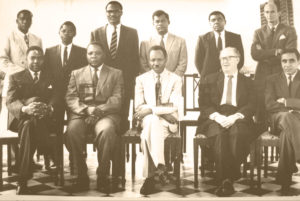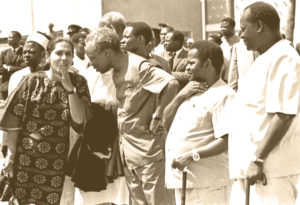Edited by Martin Walsh
INTO THE EYES OF LIONS. Graham Mercer. Matador, Kibworth Beauchamp, 2020. viii + 326 pp. (paperback). ISBN 978-1838592-295. £10.95.

Into the Eyes of Lions has a title and cover suggesting that safaris and animals are at its heart. The very first line of the introduction gives us an insight into the intrepid spirit of the author, as he tells us he “got out of the car and started walking towards the lions”. He goes on to admit it probably wasn’t the wisest thing to do, but at the time he was testing a theory of lions’ flight reactions, which the young lioness he met in Mikumi confounded. It sets the tone of many of the adventures to come.
The man walking towards the lions was Graham Mercer who grew up in an industrial town in Lancashire in the 1940s and whose interest in wildlife started early. At first, he explored the fields near his home and the skylarks, butterflies and ancient woodlands he saw set the foundation for a lifelong passion for nature and the outdoors. He came to understand the natural world as a “wonderland” and something that was entwined with his own nature. He was further inspired by his father’s stories of the tigers he had seen while serving in India during the Second World War, and increasingly it was the big cats that fascinated him. At this time, seeing them in the wild felt “unimaginable” and a “thing of dreams”, but the book goes on to recount how this became a reality for him.
His adventurous spirit led him to join the navy and here fate intervened as the Antarctic survey vessel he had been assigned to was transferred at the last moment to the tropics and so the author found himself in Mombasa. Soon afterwards he was on his first safari heading towards Kilimanjaro in a Peugeot 404 and later exploring the Tana Delta on foot. A further leave saw him being shown around by both Desmond Vesey Fitzgerald, a field scientist and honorary warden of Ngurdoto (later incorporated into Arusha) National Park and Ian Douglas Hamilton, a zoology student and authority on elephants.
After leaving the navy, a teaching job at the International School of Tanganyika, Dar es Salaam came the author’s way and his first priority was to find a “safariworthy” car he could afford. Anyone who has been on safari in Tanzania might raise an eyebrow to hear that the author settled on a Renault 4. The car is immediately tested by an arduous journey to camp in Ruaha where one of the party met a lion on his way to the latrine, luckily surviving to tell the tale, as the lion was equally as surprised. We hear about various car troubles – no hand brake, no clutch and in the Serengeti, a loud grumbling from behind the car revealed out of the dust not as a following vehicle but one of the back wheels actually coming off and rolling past.
I particularly enjoyed some of the more anthropological sections of the book such as when the author spent a night with Maasai at an enkang after giving some warriors a lift. He also recounts a visit to a Datoga village where he learned about a ceremony to honour an important man who had died six months earlier and after which the settlement would be abandoned. He met Hadzabe hunter-gatherers still living as their ancestors had, yet with the awareness of modern life encroaching on them, observing wistfully “that I was witnessing the beginning of the end of their time on Earth”.
These are digressions though and the heart of the book is firmly set on the many safaris that the author went on with friends and his wife, Anjum. The excitement and thrill of being out in nature surrounded by wildlife are palpable, anecdotes are vividly recounted, and the author was clearly extremely knowledgeable about the flora and fauna of Tanzania. Graham Mercer realised how fortunate he was to have had so many adventures in Tanzania’s National Parks and game reserves while they were still well off the beaten track and before the advent of mass tourism. On a trip to Mikumi towards the end of the book the author sees how much things have changed with modern cameras and vehicles and he sees himself suddenly, like the Hadzabe, as a “figure from the past”. The book ends as it begins with a lion sighting and there is a sense of poignancy as the author wants “to commit that last, lingering look to my memory”.
I enjoyed revisiting many of Tanzania’s wildest places in the company of the author and recommend the book to anyone interested in safaris, wildlife and the experience of a life well-lived, following one’s dream. Graham Mercer’s obituary can be read in Tanzanian Affairs #126, pp. 45-46.
Bethan Rees Walton
Bethan Rees Walton lived in Zanzibar from 1990-1996 and is the author of Images of Zanzibar (1996) with Javed Jafferji. After returning to the UK to study an MA in Social Anthropology at SOAS, University of London, she now lives in Pembrokeshire and teaches yoga by the sea. She is currently writing a novel which is set in Zanzibar.
A GARDEN GUIDE TO NATIVE PLANTS OF COASTAL EAST AFRICA. Anne H. Outwater, Ilana M. Locker, and Roy E. Gereau. Mkuki na Nyota, Dar es Salaam, 2019. iv + 252 pp. (paperback). ISBN 978-9987-08398-5. £40.00.
It was nearly 25 years ago, but how vividly I recall my disappointment when the young plants, an assortment of vegetables and ornamentals that I had tenderly grown from seeds, slumped and then gave up the ghost altogether. I had brought the seed packets back with me upon my return from a leave spent in Denmark and planted them in my little garden in Mbweni, on the southern outskirts of Zanzibar Town. Unfortunately – or, rather, fortunately! – none of the plants survived. In any event, I should have known better than to (attempt to) introduce alien and potentially invasive species, working as I was on a forest conservation project on Unguja and also having lived some years earlier in rural Pemba, where I had taken enormous delight in the few square kilometres of original indigenous forest remaining on the island. It was one of those blind spots with which many are afflicted.
Even a quick skim through A Garden Guide to Native Plants of Coastal East Africa, which grew out of a Roots & Shoots children’s club project, will obliterate any gaps in awareness regarding the critical importance of not putting alien plants into one’s coastal East African garden and instead promoting native species to the greatest extent possible. The figures are both impressive and dismal. The Swahilian region – the term the authors apply to what is also known as the Zanzibar-Inhambane Regional Mosaic, a strip of coastal forest extending from southern Somalia to southern Mozambique – has about 1,750 endemic plant species, yet 90% of the original vegetation of the region has been destroyed. The remaining 10% exists mostly as small, isolated patches.
The lead author is polymath Anne H. Outwater, a nurse at Muhimbili University of Health and Allied Sciences whose research and practical work spans homicide, tropical and infectious diseases, mental health, the potential role of beekeeping in reducing violence, and more. Co-author Ilana M. Locker has a background in biodiversity conservation and education. Roy E. Gereau, Tanzania Program Director at the Missouri Botanical Garden, is the only professional botanist among the three authors.
The core of the book is a section presenting 60 native species that are particularly suitable for garden planting. This part is sandwiched between chapters describing the coastal forest and its loss (which began with human settlement and greatly accelerated with colonial “asset stripping”), how and why foreign plants were introduced and the havoc they have wreaked, and related topics. Of practical value to the amateur gardener is a chapter explaining in detail how to go about propagating, planting and caring for native species in one’s garden.
The book opens with a suitably solemn statement by Tanzania’s Minister of State in the Vice President’s Office for Union Affairs and Environment, the Honorable January Makamba. This is followed by a warm foreword by Roots & Shoots founder and esteemed primatologist, environmentalist and UN Messenger of Peace Jane Goodall, whose association with Tanzania goes back 70 years.
In spite of my long-term interest in, and research related to, nature conservation in Tanzania, I had no idea how dire the situation was for indigenous plant species before reading A Garden Guide to Native Plants of Coastal East Africa. The negative impact on the wildlife that depends on these vegetation communities cannot be underestimated. I urge anyone with a garden in coastal Tanzania, or in other countries along the eastern African seaboard, to educate him- or herself by reading this book and to follow its sound advice.
Helle V. Goldman
Helle Goldman did her doctoral anthropological fieldwork in rural Pemba, Zanzibar, in 1992-93. In 1996-97 she was a consultant with a conservation and development project in Unguja, Zanzibar, and since then has been publishing the results of collaborative research on the role of the leopard and other wildlife in Zanzibari culture. She was most recently in Zanzibar in the summer of 2019, when she was in Mzambarauni, Pemba, following up on her earlier work there.
CHRISTIANITY IN CENTRAL TANZANIA: A STORY OF AFRICAN ENCOUNTERS AND INITIATIVES IN UGOGO AND UKAGURU, 1876-1933. Mwita Akiri. Langham Publishing, Carlisle, 2020. xxvi + 409 pp. (paperback). ISBN: 978-1-78368-778-7. £28.99.
British visitors to Tanzania will surely notice the ubiquity of religion, predominantly Islam at the coast, and Christianity in the hinterland. In central Tanzania, the subject of this book, the seeds of the Anglican Church were sown by missionaries who arrived in Mpwapwa and neighbouring districts in the early 1870s. Their exploits are well recorded in archives and written histories.
But that is only half – less than half – of the story. Bishop Mwita Akiri’s painstaking research has shown that they could have achieved little or nothing without initiatives taken by the indigenous people. Most of the chiefs gave the missionaries a kind welcome. Some built classrooms for them and urged youngsters to attend lessons as a means of gaining economic and political advancement, even though they themselves, as polygamists, rain-makers and guardians of the tradition, felt unable to accept baptism.
Missionaries needed local linguists to help them communicate. They trained school teachers who were ostensibly under missionary direction, but who in practice used imaginative illustrations and formulated strategy beyond the ability of the foreign missionaries. In the forced absence of missionaries during the Great War and on other occasions, the church, so far from declining, grew numerically and spiritually.
After analysing the culture and religion of the Gogo and Kaguru, Akiri shows that some missionaries mistakenly thought the people “had no religion and no idea of a god”, so tried to suppress local traditions among the converts – but this was always a losing battle. “Missionaries borrowed from the societies they came from, not from traditional African models.” Converts accepted Christianity on their own terms, but were attracted by the missionaries’ love, gentleness and desire to identify with the people. They were seen to be different from the German colonial authorities. Indigenous wives and “Bible women” played a key role in teaching both adults and children, even though the culture of the Church Missionary Society of the time saw women as marginal at best. Early converts from Islam showed special gifts of leadership.
Akiri traces the development of educational policies of both mission and government and shows how they moved from conflict to collaboration. Syllabuses for training teachers and clergy are outlined and show a failure to adapt to African thinking. But in spite of the requirement that passing exams was a condition for ordination, in practice academic success was often dispensed with in favour of spiritual maturity, and the ministry of lay people found to be more effective than that of “qualified” clergy. Akiri believes that the church urgently needs to learn lessons like these from the past in order to be more effective today.
Akiri’s many informants, some in their late nineties, expressed surprise at how much they could remember and gratitude that at last someone was interested in their stories. Using these unique sources, Akiri presents a balanced picture which neither glamourises missionary heroism nor sees only missionary paternalism or even contempt of indigenous culture. He has shown how the earliest church was built by teamwork.
The book suffers from the lack of an index, but readers who have lived in Tanzania will find it of absorbing interest. It revives many old memories.
Roger Bowen
Roger Bowen taught theology in Tanzania from 1965 to 1978. He was editor of the Swahili Theological Textbooks programme and has written Mwongozo wa Waraka kwa Warumi. In retirement he was chair of the Cambridge Centre for Christianity Worldwide.
EDUCATION IN TANZANIA IN THE ERA OF GLOBALISATION: CHALLENGES AND OPPORTUNITIES. Joe L. P. Lugalla & Jacob Marriote Ngwaru (eds.). Mkuki na Nyota Publishers, Dar es Salaam, 2019. 308 pp. (paperback). ISBN 978-9987083435. £ 30.00.
This book was produced as a collection of conference papers for the National Education Conference of the Aga Khan University – Institute for Educational Development, East Africa in 2016. The papers, from an eminent collection of Tanzanian researchers, are well-written. There is a wide range of topics covered, including the need for coordinated education system reform, evidence of impact from early childhood education programmes, the (unintended negative) effects of the “Big Results Now” approach in prioritising exam performance, assessment of inclusive education provision in Tanzania, the role of ICT in higher education, the role of ICT in creating a more open democracy, and more.
Many of the papers aimed to assess the status quo regarding the different areas covered. Unsurprisingly, most of the chapters concluded that current provision is inadequate, education is under-resourced, and teachers need more and better training. They also highlight the lack of trust between different stakeholders in education.
One of the more innovative papers explores the value of “making”, and advocates bringing design thinking and physical design programmes into teaching and learning to make students better equipped to solve real life problems and develop skills for deep learning.
Another raises the question “how can the national strategy on inclusive education (2009-2017) be implemented … when there are so many inclusivity challenges?” And indeed, many of the papers failed to answer the question of how the very many challenges raised for their respective area might be overcome. In general, the book covers many more challenges than opportunities, and it is not really clear how the opportunities might be taken up, given the resource constraints.
You can’t help but wonder whether this slightly dry and academic publication makes a difference to anything on the ground in Tanzania. While several “killer stats” are included about the poor state of education and at least the writers are honest about the many challenges, there is still a lack of urgency in their writing. It can’t be “business as usual” and we should be calling for radical overhaul of an education system which is delivering such poor outcomes for its citizens.
Naomi Rouse
Naomi Rouse edits the education pages of Tanzanian Affairs.


